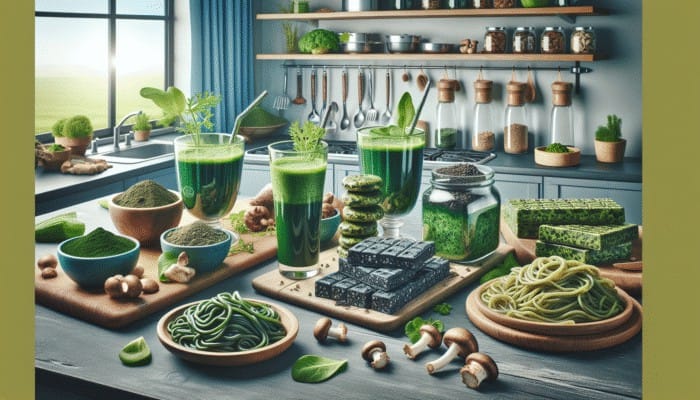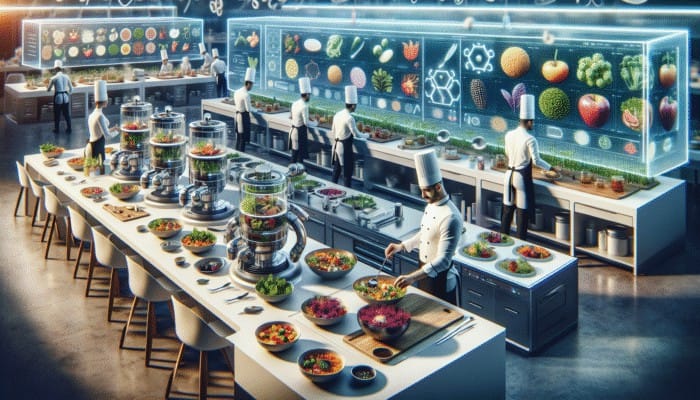Transformative Innovations in Plant-Based Cuisine
The landscape of plant-based eating is rapidly evolving, driven by a culinary innovation surge reflecting an increasing awareness of sustainability and health. The top food trends from x in 2025 are set to highlight an array of thrilling developments in plant-based foods, pushing the culinary boundaries and introducing exciting new flavours and textures that appeal to vegans and non-vegans alike. This transformation reshapes our dining experiences, making plant-based options more accessible and enjoyable for everyone.
Emerging Sustainable Protein Sources

As the search for sustainable protein sources intensifies, alternatives such as algae and fungi are emerging as revolutionary options in the culinary world. Often underrated, algae are a nutrient-dense powerhouse, brimming with essential nutrients, including high-quality protein and omega-3 fatty acids. Around the globe, innovative companies are tapping into the potential of algae to create versatile protein powders and snacks that can seamlessly be integrated into our daily diets. Spirulina, a particular variety of blue-green algae, has surged in popularity, finding its way into smoothies, energy bars, and even pasta, attracting health-conscious consumers keen on nutritious options that align with the principles of environmental sustainability.
In addition to algae, fungi are stepping into the limelight as a viable protein alternative. Mycelium, the intricate root system of mushrooms, is now cultivated to mimic the textures of traditional meat products, offering a sustainable solution to meat consumption. Through cutting-edge processing techniques, brands craft gourmet mushroom burgers and sausages that deliver rich umami flavours without the ecological footprint associated with livestock farming. The adaptability of fungi provides chefs with an exciting canvas to innovate, allowing them to create tantalising dishes that excite the palate and advocate for sustainable eating practices.
Innovations in Plant-Based Meat Alternatives
Recent advancements in the field of meat alternatives are paving the way for groundbreaking innovations that closely replicate the taste and texture of traditional meats. The top food trends from x in 2025 will likely reveal significant breakthroughs in plant-based products that will satisfy even the most discerning meat lovers. Companies are leveraging advanced technology to enhance meat mimicry, employing sophisticated techniques such as fermentation and extrusion to produce items that boast a mouthfeel comparable to beef, chicken, or pork.
Moreover, the art of flavour enhancement is crucial in this process. By experimenting with a diverse range of spices, marinades, and cooking methods, chefs can craft flavours that fulfil cravings and provide a wholesome alternative to conventional meat. These advancements cater to vegans and attract flexitarians and omnivores who appreciate the convenience and ethical considerations surrounding plant-based meats, making these options a staple in contemporary diets worldwide.
Creative Vegan Dessert Options
The world of desserts is witnessing a dramatic transformation, with innovative plant-based sweets capturing the admiration of health-conscious consumers. Vegan desserts have evolved beyond simple replacements; they now feature rich, complex flavours and textures that rival their dairy-laden counterparts. Creative chefs are embracing ingredients like coconut cream, cashew butter, and aquafaba—the liquid from chickpeas—to craft indulgent desserts ranging from decadent cheesecakes to airy mousses that delight the senses.
Additionally, the trend towards lower sugar content and including functional ingredients has led to the rise of desserts infused with superfoods, probiotics, and natural sweeteners. This shift resonates with the growing health and wellness awareness, allowing dessert enthusiasts to indulge without guilt. The landscape of vegan desserts is not merely about satisfying a sweet tooth; it embodies a holistic approach to nutrition, showcasing the thrilling possibilities that arise from plant-based innovation.
Embracing Sustainable Culinary Practices

Sustainability is becoming a cornerstone of the culinary world, with a wave of practices emerging in response to the rising consumer demand for environmentally friendly options. The top food trends from x in 2025 will illuminate sustainable practices that cater not only to eco-conscious diners but also contribute to a more responsible global food system.
Mastering Zero-Waste Cooking Techniques
Cooking with minimal waste is becoming an essential component of kitchens worldwide. Zero-waste cooking techniques encourage cooks to utilise every part of an ingredient, from root to leaf. For example, vegetable scraps can be transformed into flavourful broths, while citrus peels can be zested and candied to add an extra layer of flavour to dishes. Both restaurants and home cooks are embracing this philosophy, which reduces kitchen waste and maximises the potential of all ingredients, promoting a more sustainable approach to cooking.
This movement inspires a new wave of creativity in the kitchen, where chefs are challenged to think innovatively. They craft unique dishes that tell a compelling story of resourcefulness and sustainability by incorporating scraps and off-cuts into their menus. Such innovations resonate with consumers increasingly concerned about food waste and its environmental implications, highlighting the importance of responsible cooking practices.
Farm-to-Table: Connecting Diners with Local Produce
The farm-to-table movement continues to gain traction, underscoring the importance of sourcing fresh, locally grown ingredients. This trend reflects a commitment to supporting sustainable agriculture while providing diners with dishes bursting with flavour. By bridging the gap between consumers and farmers, restaurants illuminate the food journey from the field to the plate, fostering a deeper appreciation for the ingredients that make up our meals.
In urban areas around the globe, farmers’ markets have become vibrant hubs of community engagement, where local producers proudly showcase their crops and artisanal goods. Chefs are increasingly forming partnerships with local farms, ensuring their menus evolve with the seasons and feature the freshest produce available. This bolsters local economies and significantly reduces the carbon footprint associated with transporting food over long distances, promoting a more sustainable food system.
Innovative Eco-Friendly Packaging Solutions

As public awareness of plastic pollution grows, innovations in biodegradable and compostable food packaging are becoming paramount in the food industry. The traditional reliance on single-use plastics is being challenged, with brands exploring alternative materials derived from plants, paper, and other sustainable resources. These eco-friendly packaging options are designed to break down naturally, significantly reducing landfill waste and minimising environmental impact.
Companies worldwide are adopting these sustainable practices, responding to consumer demand for greener options. Packaging that is both functional and environmentally responsible is leading to a paradigm shift in how food products are presented and preserved, aligning with the values of health-conscious and eco-aware consumers. As this trend continues to evolve, it promises to redefine the packaging landscape, paving the way for a more sustainable future in the food industry.
Health and Wellness in the Culinary Sphere
The intersection of food and health is becoming increasingly prominent as consumers seek foods that provide benefits beyond basic nutrition. The top food trends from x in 2025 will spotlight innovations that enhance well-being and foster healthier lifestyles through dietary choices.
Exploring Functional Foods for Enhanced Well-being
Functional foods are specifically designed to deliver health benefits beyond mere sustenance, and their popularity is skyrocketing as consumers become more health-conscious. These foods are enriched with critical nutrients that can boost overall well-being, such as fortified cereals, probiotic yoghurts, and snacks rich in omega-3 fatty acids. By offering targeted health benefits—like bolstered immunity, improved gut health, or increased energy—functional foods are carving out a significant niche in the market.
This emerging trend prompts manufacturers to innovate in their product development, exploring new ingredients and formulations catering to specific health needs. For example, products infused with adaptogens—herbs believed to help the body adapt to stress—are gaining popularity among wellness enthusiasts. As scientific research continues to illuminate the connections between diet and health, the demand for functional foods is expected to escalate, paving the way for exciting advancements in this sector.
Prioritising Gut Health in Nutrition
The rising awareness surrounding gut health fosters a growing interest in foods rich in probiotics and prebiotics. These ingredients play a vital role in maintaining a balanced gut microbiome, which is linked to various aspects of health, including digestion, immunity, and even mental well-being. Consumers are increasingly looking for yoghurts, fermented foods, and supplements that promote digestive health, resulting in a surge of innovative product offerings.
Beyond traditional sources like kefir and sauerkraut, novel products are emerging that combine gut-friendly ingredients with familiar flavours, making them more appealing to a broader audience. The rise of functional beverages, such as kombucha and kefir soda, exemplifies how brands push boundaries to cater to health-conscious consumers. These trends reflect an expanding understanding of the importance of gut health in overall wellness, positioning it as a focal point in food innovation.
Embracing Mindful Eating Practices
Mindful eating encourages individuals to fully engage with their food, promoting awareness and appreciation of the eating experience. This trend is gaining momentum as consumers seek to cultivate healthier relationships with food and improve their eating habits. By focusing on the sensory elements of eating, such as taste, texture, and aroma, individuals discover that slow, deliberate eating can lead to greater satisfaction and reduced overeating.
Restaurants and food brands embrace this philosophy by designing environments that encourage mindfulness during meals. From thoughtfully curated dining spaces to marketing campaigns that promote intentional eating, the industry is responding to this growing trend. Additionally, apps and online platforms are emerging, offering resources on mindful eating practices, making it easier for individuals to incorporate this approach into their daily lives.
Transformative Technology in the Culinary World
Technology is revolutionising our food experiences, from preparation to consumption. The top food trends from x in 2025 will showcase the seamless integration of technology within the culinary realm, enhancing convenience and fostering creativity in cooking.
Personalised AI-Driven Recipe Development
Artificial intelligence is making significant strides in the culinary scene by personalising meal planning and recipe development. AI-powered applications analyse individual preferences, dietary restrictions, and nutritional needs to generate customised recipes that cater to specific tastes. This technology simplifies meal preparation and encourages home cooks to explore new ingredients and cuisines, enhancing their culinary repertoire.
For instance, users can input their available ingredients, and the AI will suggest delectable recipes that incorporate them, significantly reducing food waste and inspiring creativity in the kitchen. As this technology advances, it may also analyse emerging trends and nutritional data to recommend dishes that align with health objectives, serving as an invaluable resource for health-conscious consumers.
Revolutionary Smart Kitchen Appliances
Smart kitchen appliances are redefining home cooking by streamlining food preparation processes. These innovations, from smart ovens that automatically adjust cooking times based on recipe parameters to connected blenders that suggest smoothies tailored to a user’s health goals, make cooking more accessible and enjoyable for everyone.
The rise of smart technology in the kitchen enhances convenience and promotes energy efficiency. Many of these smart appliances are designed to optimise energy usage, aligning with the sustainable practices that consumers are increasingly prioritising. As more households embrace these technologies, we can anticipate a significant shift in cooking habits, making meal preparation more streamlined and user-friendly.
Innovative 3D Food Printing Techniques
3D food printing represents an exciting frontier in culinary technology, enabling chefs to create customised food shapes and designs that were previously unimaginable. This innovative method employs edible materials, often plant-based, to construct intricate dishes layer by layer. The potential for creativity is vast, allowing for personalised chocolates and artistically designed gourmet meals that push the boundaries of traditional dining experiences.
Moreover, beyond aesthetics, 3D printing can also tackle issues related to food waste by utilising surplus ingredients that might otherwise go unused. As chefs delve into this technology, we may witness a new wave of dining experiences that blend art with gastronomy, captivating diners and redefining their perceptions of food.
Enhanced Food Traceability Systems
Advancements in technology are simplifying the tracking of food from farm to table, ensuring safety and transparency throughout the supply chain. The implementation of blockchain technology and IoT devices is being harnessed to create traceability systems that empower consumers to understand the origin of their food, how it was produced, and its journey to their plate.
These systems enhance food safety by facilitating swift recalls in case of contamination and building trust between consumers and producers. As diners become more aware of where their food originates, the demand for transparency will likely escalate, further propelling innovation in food traceability and accountability.
Exciting Flavour Fusion Trends
Innovative flavour combinations and cross-cultural influences are reshaping the culinary landscape. The top food trends from x in 2025 are poised to highlight the thrilling possibilities of flavour fusion. Chefs across the globe are blending diverse culinary traditions to create unique dishes that expand palates and challenge conventional food pairings, resulting in a vibrant and dynamic dining experience.
Creative Cross-Cultural Culinary Dishes
The merging of culinary traditions from various cultures is giving rise to a wave of inventive, cross-cultural dishes that tantalise the taste buds. Chefs are experimenting with many cuisines' ingredients, techniques, and presentation styles, resulting in exciting new flavours that celebrate diversity. A notable example is Korean tacos, where traditional Mexican street food combines with the bold flavours of Korean barbecue, gaining traction worldwide in urban food scenes.
This flavour fusion goes beyond simple ingredient swaps; it often involves a deeper exploration of cultural significance and storytelling through food. Diners are increasingly drawn to dishes that reflect the chef’s unique heritage or culinary journey, creating connections between food and culture. As this trend evolves, we expect to see more innovative dishes celebrating global influences while resonating with local tastes.
Umami Enhancement in Modern Cooking
Umami, often called the “fifth taste,” garners recognition for elevating dishes to new culinary heights. To create depth and complexity in their culinary creations, chefs actively incorporate ingredients that enhance this savoury taste, such as fermented foods, mushrooms, and seaweed. The use of umami-rich ingredients not only enriches flavour profiles but also contributes to a more satisfying dining experience.
The growing fascination with umami encourages chefs to experiment with unconventional sources, including miso, nutritional yeast, and aged cheeses. These ingredients are staples in kitchens worldwide, allowing for a more nuanced understanding of flavour dynamics. As consumers become more adventurous in their culinary choices, the exploration of umami will likely continue to drive innovation and redefine the dining experience.
Innovative Spice Applications in Contemporary Cuisine
A diverse array of spices enters mainstream culinary use, enriching the flavour landscape with new and exotic options. Chefs are increasingly sourcing unique spices from around the globe, incorporating them into everyday dishes to create captivating flavour profiles. Spices such as sumac, za’atar, and harissa are making their way into modern menus, offering vibrant and aromatic additions to traditional recipes.
This trend not only enhances the sensory experience of dining but also fosters a deeper appreciation for spices' origins and cultural significance. As consumers seek bold flavours and diverse culinary experiences, the demand for spice innovations will continue to rise, inspiring chefs to push the boundaries of traditional cooking and create exciting new dishes.
Reviving Fermentation Techniques in Modern Cuisine
Fermentation is a time-honoured technique experiencing a renaissance in contemporary cuisine. From kimchi to kombucha, fermented foods are celebrated not only for their unique flavours but also for their numerous health benefits. Chefs are harnessing fermentation to develop complex flavours and preserve ingredients, enhancing the overall taste profile of dishes while promoting gut health.
The versatility of fermentation allows for creative applications, from using it as a marinade to crafting unique sauces and condiments. As fermentation techniques gain popularity, home cooks and chefs are delving into the science behind the process, leading to a deeper understanding of how these flavours evolve. As this trend continues to grow, we can anticipate an exciting array of fermented products enriching the culinary landscape.
Exploring Sweet and Savoury Culinary Pairings
Exploring sweet and savoury pairings is captivating diners, as chefs experiment with unexpected combinations that challenge traditional flavour boundaries. Ingredients like bacon-infused caramel, chocolate with sea salt, and spicy fruit salsas are making headlines on menus, creating balanced and intriguing flavour experiences that excite the palate.
This trend taps into the psychology of taste, encouraging diners to embrace complexity and nuance in their meals. As chefs continue to push the envelope with these innovative pairings, the culinary world is evolving, offering fresh and exciting opportunities for flavour exploration. The fusion of sweet and savoury will likely remain a captivating trend, enticing diners to venture beyond familiar tastes and discover new culinary delights.
Celebrating Artisanal and Craft Foods
The artisanal and craft food movement is redefining quality and authenticity in the culinary realm, strongly emphasising small-batch production and traditional techniques. The top food trends from x in 2025 will highlight the growing appreciation for craftsmanship and the compelling stories behind artisanal foods that connect consumers to their origins.
Embracing Small-Batch Production for Quality
The focus on small-batch production underscores a commitment to quality and uniqueness in food making. Artisanal producers craft foods in limited quantities to ensure meticulous attention to detail, producing products that often boast superior flavour and character. This trend resonates with consumers seeking one-of-a-kind culinary experiences and a genuine connection to the source of their food.
From small-batch chocolate makers to local craft breweries, these producers capture the essence of their regions and cultures, creating flavours that reflect their culinary heritage. The rise of farmers’ markets and local food festivals showcases the creativity and passion of these artisans, allowing consumers to engage directly with the makers and learn about their processes. As this movement continues to grow, it is set to shape consumer preferences, driving demand for high-quality, handcrafted products that celebrate local flavours.
Reviving Traditional Cooking Techniques
Ancient cooking methods are revived as chefs and home cooks rediscover their authenticity and richness. Methods such as smoking, fermenting, and preserving are applied to modern dishes, allowing for a deeper connection to culinary heritage while enhancing flavour profiles.
Incorporating traditional techniques encourages a more mindful approach to cooking, where the process becomes as important as the final product. This trend allows chefs to tell stories through their dishes, honouring the culinary history of their cultures while appealing to contemporary palates. As consumers increasingly seek authenticity in their food experiences, traditional techniques will be vital in shaping menus and dining experiences worldwide.
Utilising Specialty Ingredients for Unique Flavour Profiles
Modern cooking distinguishes itself by using rare and high-quality ingredients. Chefs explore unique flavours and textures that elevate their dishes to new heights. Sourcing specialty ingredients—from exotic fruits and heritage grains to artisanal cheeses—enables chefs to create menus that stand out and offer diners something truly exceptional.
This trend reflects a growing interest in terroir, the concept of how a food’s environment influences its properties. Consumers are becoming more discerning, seeking ingredients that provide authenticity and a sense of place. As the culinary landscape continues to evolve, the emphasis on specialty ingredients will play a pivotal role in shaping menus, inviting diners to experience the world through food and flavour.
Convenience and Speed in Modern Dining
With the pace of modern life accelerating, convenience and speed are increasingly paramount in the food industry. The top food trends from x in 2025 will focus on high-quality, nutritious options catering to busy lifestyles without compromising taste or health.
High-Quality Ready-to-Eat Meal Solutions
The demand for high-quality, ready-to-eat meals is rising as consumers actively seek nutritious options that require minimal preparation time. These meals are designed to offer convenience without sacrificing flavour or health benefits. From gourmet meal delivery services to pre-packaged options available in grocery stores, the market is teeming with choices that cater to busy lifestyles.
Innovative chefs are crafting dishes that are not only convenient but also reflect culinary creativity, offering a diverse array of flavours and cuisines. As these meal options evolve, we can expect a strong emphasis on fresh ingredients, bold flavours, and balanced nutrition, allowing individuals to enjoy delicious meals without the time commitment typically associated with cooking.
Meal Kits: Revolutionising Home Cooking
Meal kits have exploded in popularity, providing consumers with pre-portioned ingredients and straightforward recipes for quick and easy home cooking. This trend addresses the growing desire for convenience while encouraging individuals to engage with their food and explore new culinary creations.
Companies are offering a diverse range of options, catering to various dietary preferences and culinary skill levels. From vegetarian and vegan boxes to options tailored for families and busy professionals, meal kits are designed to simplify the cooking process and minimise food waste. As consumers become more conscious of their food choices, meal kits will likely remain a popular solution, transforming how people approach home cooking and meal preparation.
Fast-Casual Dining: The New Standard
Fast-casual dining is revolutionising the restaurant landscape by offering quick service without compromising quality. These establishments provide diners with high-quality, customisable food options in a relaxed setting, blurring the lines between traditional fast food and fine dining experiences.
This trend caters to the modern consumer’s desire for convenience while prioritising fresh, locally sourced ingredients. As fast-casual chains gain popularity, we can expect an increased focus on nutrition and flavour, appealing to health-conscious diners seeking satisfying and wholesome meals on the go.
Engaging Social Dining Experiences
How we share meals is evolving, with social dining experiences becoming a central focus in the culinary world. The top food trends from x in 2025 will emphasise the significance of communal dining and interactive experiences that promote connection and community engagement among diners.
Interactive Dining Experiences: Cooking with Engagement
Interactive dining experiences capture diners by inviting them to participate in the cooking or presentation process. From DIY sushi rolls to build-your-own tacos, these meals encourage engagement and foster a sense of fun and collaboration among guests.
Such experiences enhance the enjoyment of the meal and cultivate a deeper connection between diners and the food being served. As restaurants increasingly embrace this trend, we can anticipate a rise in creative and immersive dining concepts that celebrate shared experiences and cultivate a sense of community among diners.
Exciting Themed Dining Events
Themed dining events are gaining popularity. They provide diners with unique culinary experiences centred around specific themes or cuisines. From regional food festivals to pop-up dinners featuring guest chefs, these events create an atmosphere of excitement and exploration for food lovers.
Themed events allow chefs to showcase their creativity and connect with diners on a deeper level, celebrating the cultural significance of food and its diverse narratives. As consumers seek more meaningful dining experiences, themed events are likely to play a crucial role in shaping the future of dining, enticing individuals to step out of their comfort zones and discover new flavours and culinary traditions.
Communal Dining Tables: Fostering Connection
Communal dining spaces are rising, encouraging shared meal experiences that foster connection and community. By bringing people together around a single table, restaurants create an environment that promotes social interaction and engagement, redefining how we share meals.
This trend reflects a growing desire for meaningful dining experiences, where guests can connect and share their culinary journeys. As communal dining continues to gain popularity, it will reshape our perceptions of dining out, turning meals into opportunities for connection and camaraderie among diners.
Championing Ethical Eating Practices
As awareness of ethical considerations in food production expands, consumers increasingly seek options that align with their values. The top food trends from x in 2025 will spotlight the importance of ethical eating, focusing on fair trade practices, animal welfare, and responsible sourcing.
Supporting Fair Trade Ingredients
Fair trade ingredients are becoming a staple in the conscious consumer’s pantry. By supporting ethical sourcing practices, brands ensure that producers receive fair compensation for their work, fostering sustainability and community development.
As consumers become more aware of the impact of their purchasing decisions, the demand for fair trade products continues to rise. This trend inspires brands to enhance transparency surrounding their sourcing practices, enabling consumers to make informed choices reflecting their values and commitment to social responsibility.
Prioritising Animal Welfare in Food Production
The increasing focus on the humane treatment of animals is shaping consumer preferences, as more individuals seek products that prioritise high welfare standards. This trend prompts producers to adopt more ethical practices, ensuring that animals are raised in humane conditions that respect their well-being.
As consumers become more discerning about the origins of their food, the demand for ethically produced animal products will likely continue to grow. Brands that prioritise animal welfare are set to resonate with today’s conscientious consumers, reinforcing the significance of ethical considerations in food production and consumption.
Advocating Sustainable Fishing Practices
Sustainable fishing practices are gaining recognition as consumers actively seek seafood options that support ocean health and biodiversity. By prioritising responsible sourcing, restaurants and retailers can ensure that their seafood is harvested in ways that minimise harm to marine ecosystems and promote sustainability.
This trend reflects a broader awareness of the impacts of overfishing and habitat destruction, prompting consumers to make informed choices about their seafood consumption. As the demand for sustainable seafood continues to rise, we can expect a growing number of initiatives promoting responsible fishing practices and safeguarding our oceans for future generations.
Ensuring Transparency in Food Sourcing
Transparency in food sourcing is becoming a critical factor in consumer decision-making. Diners want to know where their food comes from and how it was produced, prompting brands to prioritise clear communication regarding their sourcing practices.
As technology enables greater traceability, consumers can make informed decisions about the products they choose. This trend builds trust between consumers and brands and fosters a deeper connection to the food they consume, enhancing the overall dining experience.
Raising Awareness of Environmental Impact
Increasing awareness of the environmental impact of food production motivates consumers to seek sustainable options. From embracing plant-based diets to opting for locally sourced ingredients, individuals make choices that align with their values while prioritising the planet's health.
This trend reflects a growing understanding of the interconnectedness of food, health, and environmental sustainability. As consumers become more conscious of their ecological footprint, the demand for sustainable practices in the food industry will likely continue to rise, reshaping the future of dining and food consumption.
Frequently Asked Questions (FAQs)
What are the top food trends from X in 2025?
The top food trends from x in 2025 encompass plant-based innovations, sustainable practices, health-focused foods, technological advancements in the culinary world, flavour fusion, artisanal production, convenience options, social dining experiences, and ethical eating.
How are plant-based innovations changing the food industry?
Plant-based innovations are introducing new protein sources like algae and fungi, advancing meat alternatives, and creating inventive vegan desserts, catering to health-conscious consumers and promoting environmental sustainability.
What is zero-waste cooking?
Zero-waste cooking involves utilising every part of an ingredient to minimise kitchen waste. Techniques include crafting broths from scraps and creatively using vegetable peels, all promoting sustainability in home cooking.
How do functional foods benefit health?
Functional foods provide benefits beyond basic nutrition, such as improved immunity or enhanced gut health, through ingredients fortified with probiotics, vitamins, and minerals.
What role does technology play in modern cooking?
Technology enhances modern cooking through AI-driven recipes, smart kitchen appliances for convenience, 3D food printing for creativity, and food traceability systems ensuring safety and transparency in sourcing.
What are some examples of flavour fusion in cuisine?
Flavour fusion includes innovative dishes like Korean tacos, which combine Mexican and Korean cuisine elements, and creative sweet and savoury pairings that challenge traditional taste boundaries.
What is the significance of artisanal and craft foods?
Artisanal and craft foods prioritise quality and authenticity through small-batch production and traditional techniques, appealing to consumers seeking unique culinary experiences and meaningful connections to food sources.
How are meal kits changing home cooking?
Meal kits provide pre-portioned ingredients and easy-to-follow recipes, making home cooking more accessible. They also encourage individuals to explore new cuisines while minimising food waste.
What are communal dining experiences?
Communal dining experiences involve shared meal settings, which foster connection and social interaction among diners and create a more engaging and meaningful dining experience.
How does ethical eating impact consumer choices?
Ethical eating influences consumer choices by prioritising fair trade practices and animal welfare, increasing demand for sustainable products that align with personal values and social responsibility.



I love the direction plant-based cuisine is heading! The rise of alternatives like algae and fungi is particularly fascinating to me. I recently tried a dish made with spirulina, and it was a game-changer—full of flavor and packed with nutrients. It’s exciting to think about how these underrated ingredients can reshape our meals and our planet’s health.